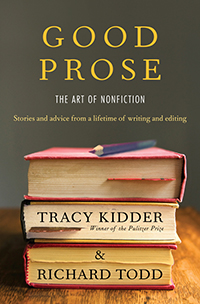Posted Feb. 25, 2013
“Good Prose: The Art of Nonfiction”
Tracy Kidder and Richard Todd.
By NANCY CERMENO
“Good Prose: The Art of Nonfiction” by Tracy Kidder and Richard Todd is a love letter. It is a love letter to the great English writers, to future writers, to readers, and to the language itself. But most of all “Good Prose” is a gift.
 Tracy Kidder met his longtime editor Richard Todd in 1973 at a Boston brownstone, home to The Atlantic magazine.
Tracy Kidder met his longtime editor Richard Todd in 1973 at a Boston brownstone, home to The Atlantic magazine.
A more “perfect or equal” setting could not be imagined. The old headquarters had an undeniable sense of lineage. Kidder recalls walking into an office and studying the signatures of Twain, Emerson, Thoreau, and Edith Wharton, all who were published in The Atlantic.
Back then Tracy Kidder was a well-educated writer who just wanted to be published. His education however did not translate into good writing. His first Atlantic article had to be rewritten many times, but Kidder considered rewrites a privilege.
Todd told Kidder that the piece needed fixing and Kidder was happy to oblige, ignorant to the fact that the editor-in-chief of The Atlantic, Bob Manning,had scribbled, “Let’s face it, this fellow can’t write,” on his first manuscript.
Todd found Kidder to be a useful freelance writer thanks to his willingness to rewrite and his “boundless energy.” The ritual of Todd pointing out problems and Kidder fixing them went on for five years in the offices of The Atlantic.
Kidder soon wanted to do more than write articles as he recalls in the book:
“I was broke, I explained once again. I was tired of writing articles. I wanted to write a book, a better book then I had written before. What could I write a book about?
Todd said, “Why don’t you look into computers?”
In 1982, Kidder received the Pulitzer Prize in General Nonfiction for “The Soul of a New Machine,” about a team of Boston computer engineers who had the daunting task of designing a mini-computer for a competitive market in a short amount of time.
In hindsight Kidder credits luck for his success while admitting that as a writer in his thirties he was too young to realize it. He contemplates:
“Think of the many wonderful writers who haven’t earned a living by writing. Anyone who does earn a living by writing, and does not acknowledge the power of luck, has to be deluded.”
The book asks its readers to not be afraid of writing badly. It also insists on the importance of rewriting. The authors promise that even the worst writers will eventually become better if they take others advice humbly and get on with it. Kidder and Todd state in the introduction:
“That you can learn to write better is one of our fundamental assumptions. No sensible person would deny the mystery of talent, or for that matter the mystery of inspiration. But if it is vain to deny these mysteries, it is useless to depend on them. No other art form is so infinitely mutable. All prose responds to work.”
Richard Todd gives us an authoritative inside look into his professional life as a writer, editor, publisher and critic. What he reveals in Good Prose is useful to anyone who cares about books. He knows he is good at pointing out problems but he never fixes them himself. He believes in those he edits and cares very little for commercial success despite working towards it. In his chapter on Art and Commerce, Todd writes:
“Whatever art any book achieves may or may not be rewarded in the marketplace, but art isn’t generally achieved with the market in mind. Every book has to be in part its own reward. It is something done for its own sake.”
Through memoir and great examples in literature and nonfiction, Todd and Kidder attempt to reveal the art of nonfiction. They are as successful as they can be since the art is in the mystery. Todd explains:
“All good writing ultimately is a contest with the inexpressible. Every good passage leaves something unsaid. So it ought to be hard. But you don’t want to make it harder than necessary. The best thing an editor can do is to help the writer to think, and this is the most satisfying part of an editor’s work, collaborating at the level of structure and idea.”
The book describes the art of beginnings, clarity with depth, character, style and the elusive search for voice. At times it is didactic, romantic and funny. It is the textbook on writing nonfiction well, yet it reads like a friend giving you sincere advice.
If you do not have H.W. Fowler’s “Modern English Usage” on your shelf, and your mom did not read you Dickens as a bedtime story then you should read this. If you got the best English education money can buy, you should still read this. And if you know all there is to know about writing, you should read this to say “Amen” at the end of every chapter. Todd and Richard succinctly describe the book:
“This book is in part an account of lessons learned by a writer and an editor working together over nearly forty years. “Good Prose is addressed to readers and writers, to people who care about writing, about how it gets done, about how to do it better.”
- “Good Prose: The Art of Nonfiction”
- Tracy Kidder and Richard Todd
- Random House
- $26 (240 pp.)
- Released: Jan. 15, 2013
